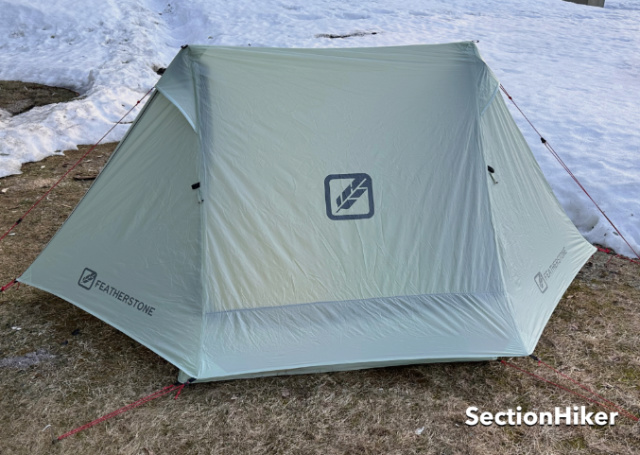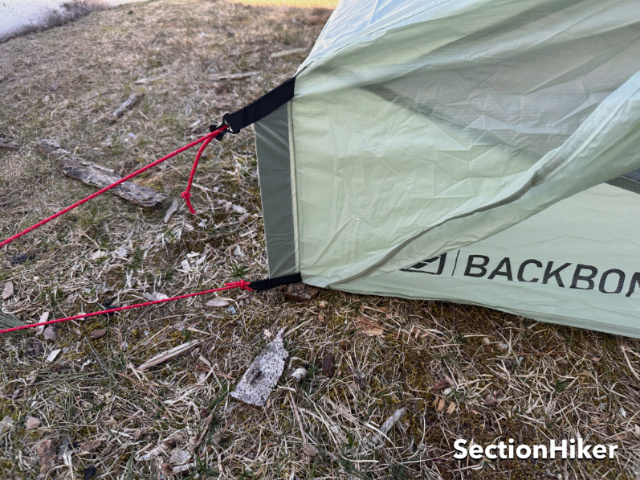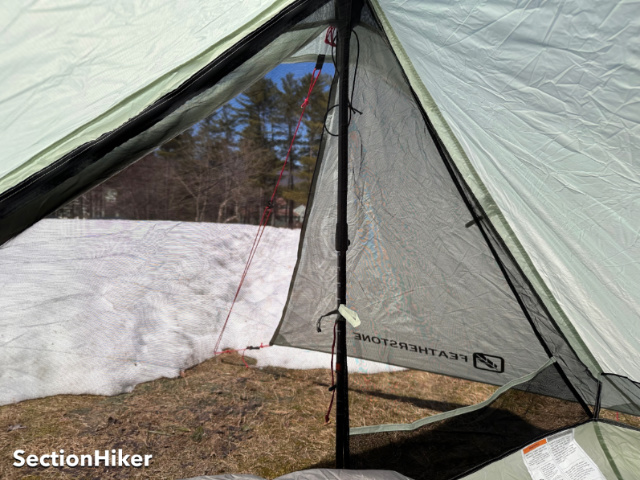The Featherstone Backbone 2P Trekking Pole Tent is an affordable ultralight single-wall tent for two people that requires two trekking poles to set up. Weighing 2 lbs 11.5 oz, it’s relatively inexpensive ($179.99), but has many features found on much more expensive ultralight tents including peak vents, corner struts, line loc tensioners, TPU waterproof door zippers, and dual vestibule hooks. It’s made with PU-coated silnylon, so it’s seam-taped and comes complete with 15 tent stakes.
Specs at a Glance
- Type: Single Wall, Trekking Pole Tent
- Sleeping Capacity: 2 Person
- Doors/Vestibules: 2/2
- Interior Pockets: 2
- Seam Taped: Yes (some touch-up recommended)
- Head width: 50 in / 127 cm
- Foot width: 43 inches / 109 cm
- Length: 84 in / 215 cm
- Height: 47 in / 120 cm
- Minimum number of stakes to pitch: 6; Recommended: 8 or 9.
- Material: 20D Silnylon with 2000mm PU coating
- Mfg. Trail Weight: 2 lbs 11.5 oz / 1233g
- Actual Trail Weight: 2 lbs 7.7 oz / 1124.5g
- Footprint Included: No
The Featherstone Backbone 2P tent is a two-person single-wall tent with two doors and two vestibules. Setup requires two trekking poles that slot into reinforced sleeves (handle up) in the two peaks and grommets (tips down) alongside the sides of the bathtub floor.

The setup is directional with a distinct head end and foot end: the interior is split 60/40 (foot/head) by length to maximize headroom rather than being split 50/50. The interior is quite livable as a result. The interior floor is tapered to save weight and 50″ at the head end, narrowing to 43″ at the foot end, so you’ll want to use tapered mummy sleeping pads if you prefer wide ones with 25″ widths.

The Backbone 2P requires a minimum of 6 stakes to pitch – 4 in the corners and 2 on the vestibule doors. Each corner has one guyline which is attached to the tent in two places (to help create more height) with a metal ring in the middle which you stake out. These corner guylines also have lineloc tensioners to easily tension the floor and fly.
The two vestibule doors have waterproof zippers and peak vents lined with noseeum mesh. The vestibule zippers don’t have rain gutters, however, so you can expect to get wet if you open them in the rain. The bottom of the vestibule doors have dual hook closures, first popularized by Zpacks, that let you use one stake to hold both doors closed when zippered together, both doors closed but unzipped, or one of the doors closed and the other tied back.

The foot end of the tent is augmented with PE struts in the corners that help raise the ceiling higher and create increased volume over the feet. Tarptent was the first manufacturer to use such struts for this purpose, but you now see more and more tent manufacturers beginning to adopt this approach, including Zpacks and REI. It’s particularly useful on pyramid-shaped tents or tents with steep sloping ceilings.

The head end of the bathtub floor is sewn to the ceiling with noseeum mesh for additional ventilation while the fly creates an awning over the mesh to prevent rain from entering. But the seam where the mesh attaches to the fly should be seam-sealed (link to instructions), a design oversight, given that the rest of the tent is seam-taped and does not require seam-sealing. A tube of seam-sealer is included with the tent for this purpose. This is a very simple process but should be done before use.

The sides of the tent are all mesh with large pockets at their base along the head end so you don’t crush personal items. When camping, I’d recommend sleeping with the side vestibules rolled back, completely or partially, to maximize airflow through the tent and reduce internal condensation. All single-wall tents experience internal condensation: it’s not a property of the tent per se, but of the temperature differential that occurs between the inside of the tent and the exterior. Airflow is the best way to mitigate condensation because it equalizes the internal and external temperatures of the ceiling and walls.

When pitching the tent, there are a few things you’ll want to watch out for.
- The fabric panel over the foot end tends to droop, but there is a guy-out point on it. I’d recommend staking it out with a tree branch or trekking pole to maintain the tent’s interior volume. This isn’t critical, but it makes for a much neater and tauter pitch.
- There are additional guyout loops on top of the peaks that are good to use in windy conditions and provide a more secure pitch. If you use them, you can completely roll back both vestibule doors for added ventilation.
- You can also lengthen your trekking poles more than the 47″ peak height for more airflow, although doing do will care the peak vents to collapse. This is no great loss however because they do not have kickstand props inside anyway and are marginally effective as is.

Comparable UL tents under $300
Accessories
The Backbone comes with a compression sack so it’s easy to pack. While the tent comes with steel shepherds hook tent stakes, I’d recommend upgrading them with something lighter weight with better-holding power like MSR mini-ground hogs or Paria UL Needle stakes which have flanged or square shafts instead of round ones. Extra guylines with tensioners are also included, but the tent does not come with a footprint, since more people use a lighter-weight substitute like plastic window wrap when a footprint is called for.

Recommendation
The Featherstone Backbone 2P is an affordable ultralight trekking pole tent that’s a pretty good value for the money. It has a lot of features that you’ll find on more affordable non-Dyneema ultralight tents under $300 and it’s quite lightweight at 2 lbs 11.5 oz (although our tent weighed about 4 oz less). Keep in mind that the Backbone is a single-wall tent that will be prone to internal condensation unless you keep the doors wide open for increased airflow. That is the nature of all single-wall tents. If you don’t want to sleep with the vestibule doors wide open, I’d recommend getting a double-wall tent instead.
The closest competitor to the Backbone 2P is the single-wall 3FUL Lanshan 2 Pro, which is slightly more expensive. While both are made overseas, as is the case with most ultralight tents, I like the Featherstone tent because they have US-based management and customer service, so you have someone to call if you run into problems. That said, the Lanshan 2 Pro has a good track record and is a good buy as well.
On a final note, I’m happy to see that an increasing number of companies are producing more affordable ultralight tents than the much more expensive models currently available. Ultralight backpacking was never meant to be an elitist pursuit and the availability of lower-cost, good-quality gear will certainly benefit those who want to try it.
Disclosure: Featherstone donated a tent for this review.
SectionHiker is reader-supported. We only make money if you purchase a product through our affiliate links. Help us continue to test and write unsponsored and independent gear reviews, beginner FAQs, and free hiking guides.
